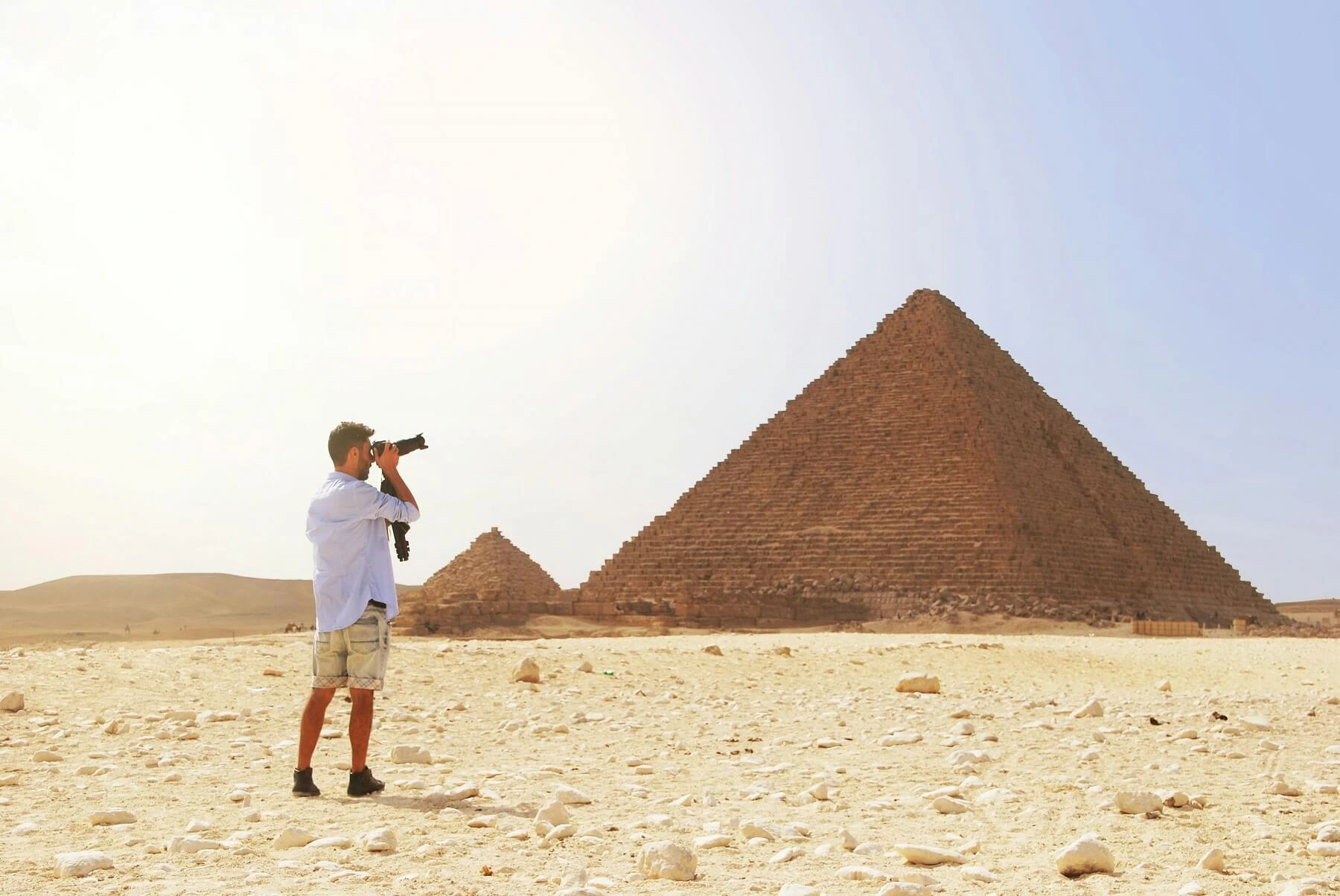Curious about the magic behind one of Egypt’s most awe-inspiring ancient sites? This article takes you deep inside the story of Edfu Temple, revealing not only its historical significance but also the powerful symbolism etched into every stone. From the myth of Horus and Seth to surprising architectural details rarely mentioned in guidebooks, you’ll explore how this temple blends religion, astronomy, and engineering into one unforgettable experience. Whether you’re planning your Nile River cruise dahabiya or just want to journey through time, this is your essential guide to the mysteries of Edfu.
Edfu Temple History
The Edfu Temple was a sacred sanctuary built to honor Horus, the falcon-headed god of kingship and sky. According to the Temple of Edfu story, this exact site marks the mythical battleground where Horus defeated his uncle Seth, the god of chaos. But beyond mythology, it functioned as a religious hub—hosting festivals, welcoming pilgrims, and serving as a stage for daily offerings and royal ceremonies. Priests performed sacred rituals here to invoke Horus’s protection over Egypt.
The Edfu Temple history holds immense significance as it’s the best-preserved and most complete of all Egyptian temples. Constructed between 237 and 57 BCE during the Ptolemaic period, it offers a remarkably intact glimpse into ancient religious life. The sandstone walls are etched with hieroglyphic inscriptions that record ceremonial rites, mythological scenes, and details about Horus’s sacred solar barque. These preserved carvings provide rare insight into the spiritual and political role of temples in ancient Egypt.
Standing on the west bank of the Nile River, the temple is located in the modern town of Edfu, between Luxor and Aswan. Today, it is a beloved stop on many Nile River cruises, typically paired with Kom Ombo Temple. The site was chosen for its sacred association with the legend of Horus, and remains a vivid symbol of Egypt’s spiritual depth and architectural mastery.
For travelers who want to combine the wonders of Cairo with the serenity of sailing the Nile, a 14-day Cairo and dahabiya nile cruise offers the perfect journey, blending ancient history with a luxurious river experience.
Edfu Temple Architecture
What makes the architecture of Edfu Temple so remarkable?
The Temple of Horus, as it’s also called, is one of the most exceptional examples of ancient Egyptian religious architecture. Thanks to centuries of burial beneath desert sand and silt, the structure was preserved from looters and erosion. As a result, the Edfu temple inside remains in near-pristine condition, offering modern visitors a rare chance to walk through history.
Notably, architects left behind detailed construction guides etched into the walls, making it one of the few temples whose blueprint is partially recorded in its own stone. This makes Edfu a fascinating case study in ancient engineering and sacred design.
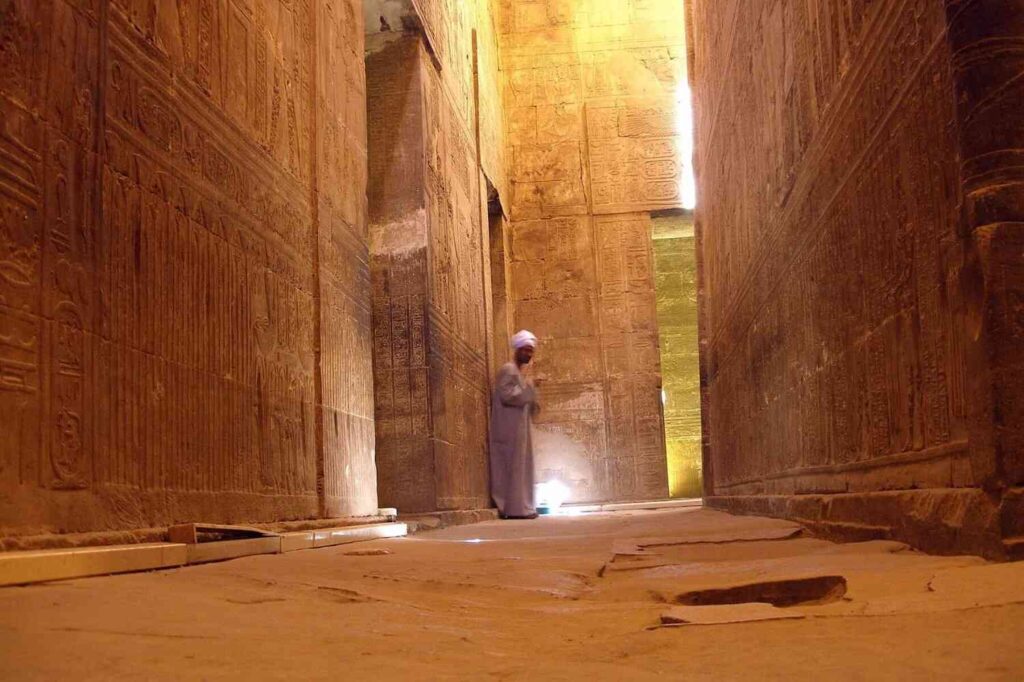
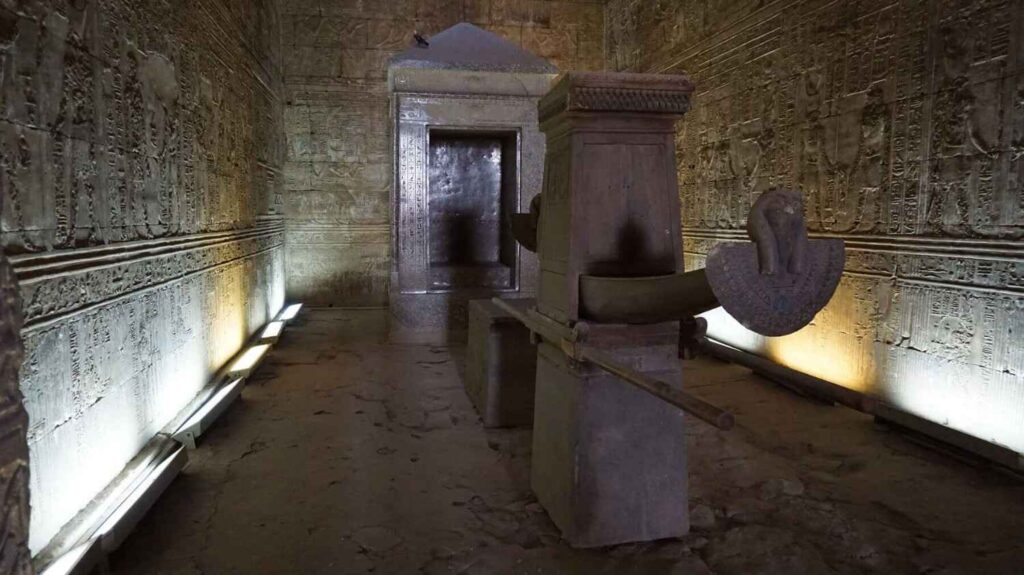
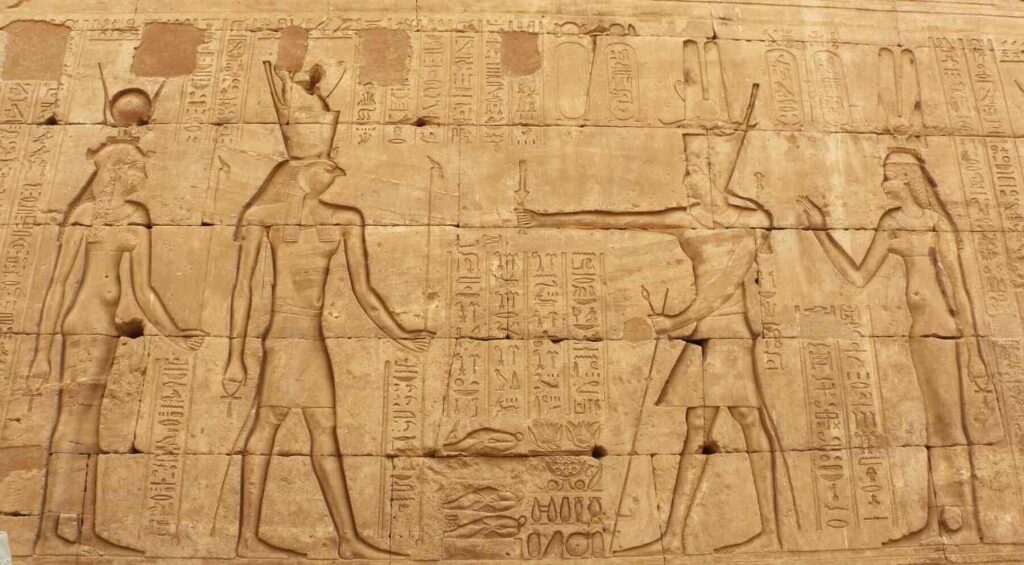
Edfu Temple Architecture Facts
- The colossal main pylon stands over 36 meters tall, showing Horus vanquishing his enemies—an impressive and symbolic gateway.
- Its alignment with the western horizon reflects celestial connections to the solar cycle and Horus’s mythic battles.
- The hypostyle hall holds twelve massive columns shaped like lotus and papyrus—icons of rebirth and unity.
- A secretive ritual chamber inside the temple functioned as a lab for sacred oils and perfumes, with recipes carved on its walls—still readable today.
- Uniquely, the outer walls document the temple’s entire construction process, from tools to labor divisions—rare for any ancient monument.
These Edfu Temple architecture facts reveal a structure that wasn’t only spiritual, but also scientific and methodically planned.
Edfu Temple Architecture Timeline
The temple’s construction began under Ptolemy III in 237 BCE and was completed by Ptolemy XII in 57 BCE—spanning nearly 180 years. Remarkably, this long process maintained stylistic unity, thanks to the blueprints carved into the stone itself.
In certain chambers within the Temple of Edfu, you can still see grid marks and unfinished sketches, hidden beneath the final carvings. These layers act like time capsules, revealing the intricate planning and multi-generational craftsmanship that went into building the Horus temple.
Edfu Temple Architecture Characteristics
The temple’s layout mirrors a symbolic spiritual ascent. Its design isn’t just aesthetic—it’s philosophical:
- The open forecourt represents the earthly realm.
- The hypostyle halls mark a threshold between human and divine.
- The sanctuary, located deep within, embodies the presence of Horus himself.
As you step farther into the Temple of Horus, ceilings gradually lower, corridors darken, and hieroglyphs shift from public proclamations to esoteric spiritual symbols. This architectural journey subtly guides the visitor from the physical world into the heart of divinity—an intentional emotional and spiritual transformation.
Above select chambers, you’ll find astronomical maps carved into the ceilings, used to mark sacred events such as the Feast of the Victory of Horus. In a rarely noted chamber, a darkened ceiling simulates night, used for rituals that reenacted Horus’s voyage through the underworld. These features are not often highlighted in guidebooks but demonstrate how the ancient Egyptians used space, light, and symbolism to evoke divine experience.
The Myth of Horus and Symbolism in the Temple of Edfu
The Temple of Edfu is more than stone and story—it is a sacred theatre of divine power. This is where ancient Egyptians believed Horus struck down Seth to avenge Osiris, restoring harmony to the universe.
Every chamber, every wall relief inside the temple of Horus, echoes this myth. From falcon-headed statues to carvings of ceremonial processions, the space is built as a narrative—the triumph of order over chaos, of light over darkness.
- Falcon imagery reinforces Horus’s watchful dominion over the sky.
- Columns bearing lotus and papyrus recall unity between Upper and Lower Egypt.
- Even false doors behind sanctuaries were believed to be portals for Horus’s spirit to accept offerings.
One of the most awe-inspiring experiences is standing inside the sacred barque shrine, where Horus’s gilded statue once sailed during festivals. The chamber is still shadowed and silent, yet feels alive with ritual memory.
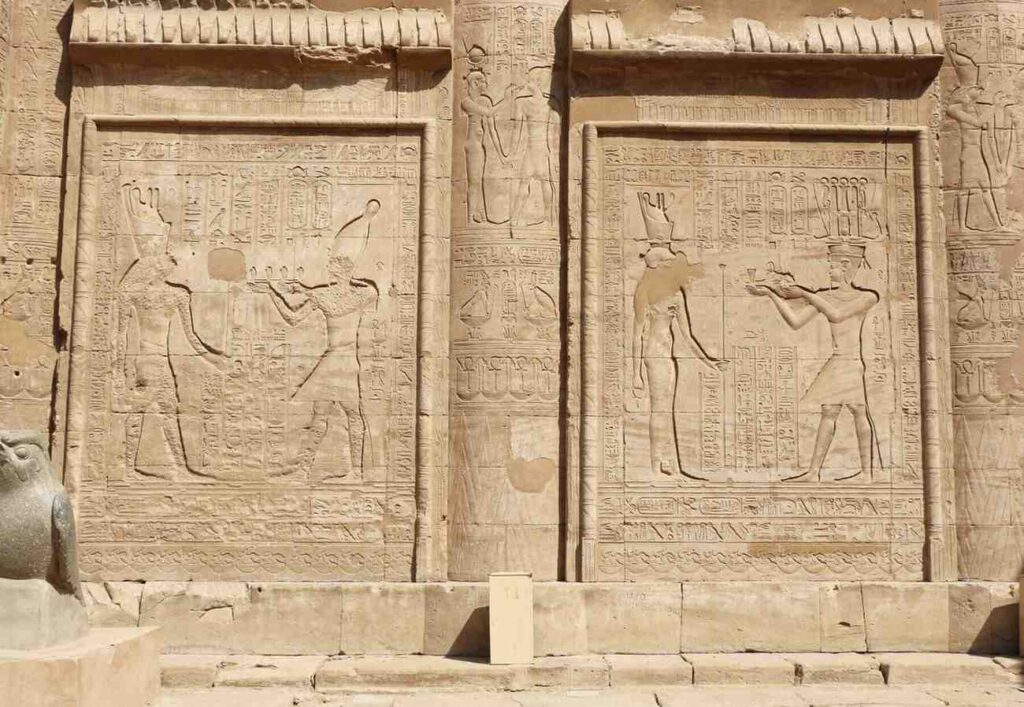
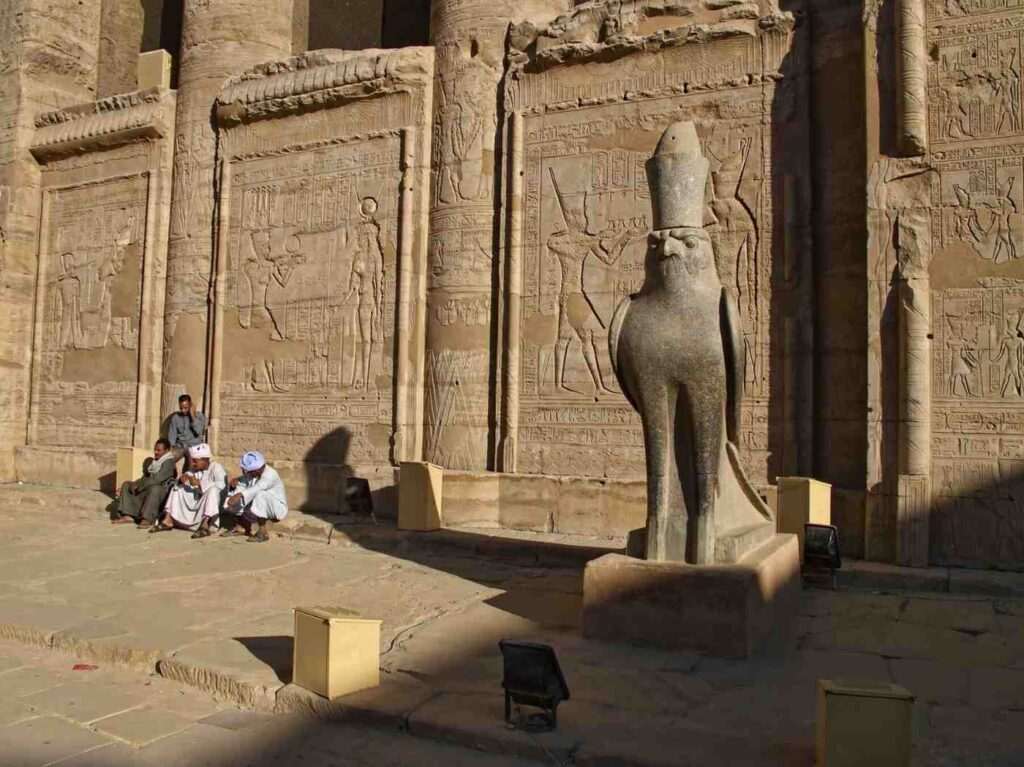
A Living Monument to Divine Power
Whether you’re drawn by mythology, architecture, or spiritual wonder, the Edfu Temple offers more than a historical tour—it delivers an emotional journey crafted in stone. This rare blend of symbolism, preservation, and immersive storytelling makes it one of Egypt’s most unforgettable ancient wonders perfect to experience on a 7-day private dahabiya nile cruise or even a shorter 4 dahabiya nile cruise


